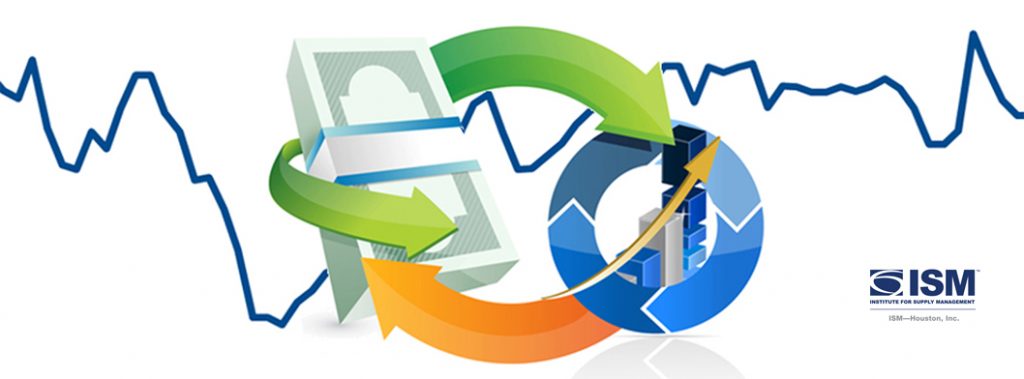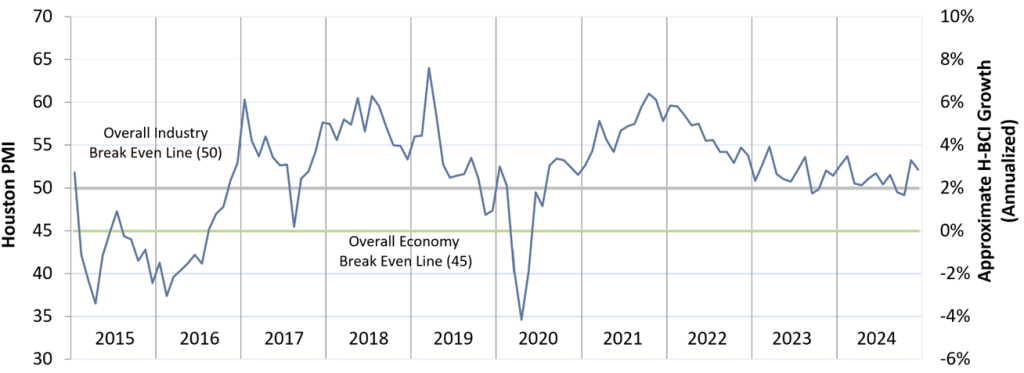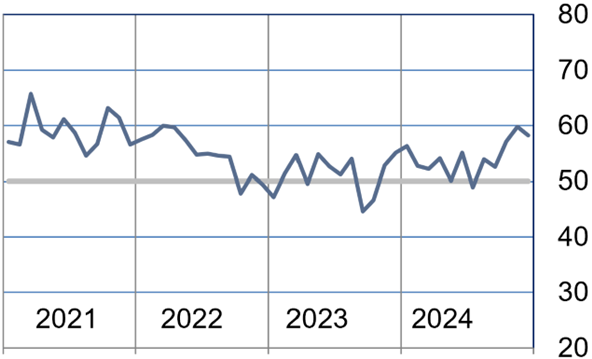
For release January 10, 2025
Houston PMI at 52.1 (down 1.1 points)
Sales/New Orders Expanding
Production Expanding
Employment Expanding
Prices Paid Expanding
Lead Times Contracting
Finished Goods Inventories Contracting
(Houston, Texas) – According to Houston area supply chain executives, economic activity in Houston showed positive results in December, with both manufacturing and non-manufacturing sectors indicating moderate expansion. The overall economy expanded for the 55th straight month.
The Houston Purchasing Managers Index decreased 1.1 points to 52.1 points. Sales/new orders, employment and lead time are the top three indicators with a strong positive correlation with the Houston economy. This month, two of the three indexes expanded with one contracting. Employment continued its month over month expansion, decreasing 0.4 points to 50.3 points. Sales/new orders continued multi month expansion. Sales/new orders dropped 1.6 points to finish at 58.2 points . The third indicator (lead times) contracted at a faster rate than November, falling 2.6 point to finish at 47.0 points. The finished goods inventory index, the underlying indicator that has the strongest inverse correlation with economic activity, decreased 0.4 points to 48.7 points.
The Houston Manufacturing PMI increased 3.1 points to 52.2 points, changing from contraction to expansion. The nonmanufacturing PMI decreased 1.9 points to 52.1 points.
On an industry specific basis: Construction, nondurable goods manufacturing, transportation and warehousing and leisure and hospitality reported strong expansion. No sectors reported significant contraction.
Click here to see the PDF version of the full report.
Indices at a Glance

Houston PMI Trend
Houston PMI readings over 50 generally indicate that respondents see their activities as expanding. An HPMI above 45 normally correlates with expansion of the Houston-The Woodlands-Sugar Land Business Cycle Index (H-BCI).

Commodities Reported to have Notable Price Changes or to be in Short Supply
Up in Price: Trade labor, logistics services, ethane, propane, butanes, ethylene, glycol, natural gas, catalyst, electrical gear and components, transformers, elastomers, switchgear, domestically manufactured steel products, imported goods, ocean container freight, waste management services
Down in Price: Discretionary services, fuel, stainless steel, steel products, Chinese carbon steel, copper, nickel, silver, palladium, luxury goods
In Short Supply: Technical labor, glycols, PFA components, electronics, electrical gear, electrical components, generators, transformers, low pressure hammer union components
‡ reported as up or down by different respondents
What our Respondents are Saying
Oil and Gas Exploration, and Key Support Services:
- Northern white sand was down 10% and locked this deflation in for the balance of the year.
- Could see impacts from potential tariff & port strike potential in US
- Scenario planning around potential tariff impacts to key products/materials.
- This sector’s performance decreased slightly vs November, continuing its contraction. Sales expanded and production saw expansion as well. Employment saw a significant improvement; however, it still came in as slightly contracting. Lead times contracted faster than November.
Construction:
- Motor fuel prices remain at reasonable levels.
- Our ocean freight prices for materials coming from overseas have been rising since October.
- This sector indicated strong growth for the month of December. Seven of the eight indexes indicating expansion. Only prices indicated slight contraction.
Durable Goods Manufacturing:
- US polyethylene and polypropylene price rose modesty after hitting a 12-month low in November
- Business activity overall for the calendar year wasn’t as strong as hoped for compared to 2023. Business activity was stronger overall in the second half of the year compared to the first half of the year. Policies of the incoming Presidential Administration in regard to tariffs, oil & gas exploration and production, and taxation will likely affect business activity for the upcoming year. Commodity pricing was mostly stable throughout the course of the year.
- Durable goods moderate contraction in December; there was a dramatic decrease sales and production versus November. Employment and lead times continued to see expansion and the full goods inventory saw a sharp decrease versus November.
Non-durable Goods Manufacturing:
- Natural gas prices continue to increase from record lows hit in 2024
- Propane prices fell through the middle of the month but recovered at month end
- Olefins cracker feedstock prices rose considerably (5-15%) in December
- This sector moderately expanded in December; sales and employment saw strong expansion; however, purchased inventory is weak, indicating significant contraction. The full goods inventory stayed in expansion.
Trade, Transportation, and Warehousing:
- This sector’s performance indicated moderate expansion for the month of November. The sales index indicated strong expansion, which was accompanied by strong production and prices. The sector saw contraction in employment and full goods inventory.
Professional and Business Services:
- The trend for the People Business in Houston appears to be ready for some expansion. The amount of expansion will depend on the intensity of the Federal Govt to loosen up some of the restrictions and regulations that contributed to un-easiness in the energy sector. If Congress can act on the majority of the New Administration desires, I think the Energy sector will respond positively with increased spending on all fronts.
- Very stable employment market for the moment particularly in Energy sector. But our clients are saying that budges will include some room for expansion and hiring.
- The People business (both for Direct Hire and Professional Contract Services) we believe will pick up in activity during the 1st and 2nd qrt. Optimism is high in general.
- Prices for Direct Hire and Professional Contract Hourly Services seem to be trending up as we start the new year.
- This sector’s performance indicated moderate expansion. The sales and employment indexes indicated strong expansion, with prices and the employment seeing slight contraction.
Retail Trade:
- Interest rates still having an effect on reduced spending, but customer optimism post-election is being seen and translating to growing demand.
- This sector’s performance indicated strong expansion for the month of November. The sales index indicated strong expansion. Only the price index saw contraction.
Wholesale Trade:
- Awaiting New President’s decisions and actions in 2025, purchases prior to tariffs, back orders on service parts up, car sales up over last year’s numbers
- This sector’s performance indicated moderate expansion for the month of December. All indexes indicated expansion. Prices saw significant expansion.
Transportation and Warehousing:
- US air passenger traffic rose in December consistent with normal seasonal trends; year to date traffic is well above last year’s record level; Houston passenger traffic was also well above last year’s record.
- This sector’s performance indicated strong expansion for the month of December. Only the employment index indicated slight contraction. All other indexes indicated expansion.
Trend of Underlying Indicators
The Houston PMI is based on diffusion indices for eight underlying indicators. The net value of each indicator is simply the percentage of respondents who cite a positive shift from the previous month minus the percentage who cite a negative shift. The diffusion index is calculated based on the percent of respondents reporting higher results plus one-half of those responding the same with seasonal adjustments to the Sales/New Orders, Production, Employment, and Prices Paid indices based on an X13 ARIMA forecast. Values above 50 for Sales/New Orders, Production, Employment, Prices Paid, and Lead Times generally point towards expansion and values below 50 signal contraction. Note that the Prices Paid Index may not follow this trend late in an economic expansion. The Inventory measures have an inverse correlation at most forecast horizons, meaning that values below 50 point to expansion and values above point to contraction. The Purchases index is inversely correlated with economic activity at the three-month forecast horizon.
Sales/New Orders (Seasonally Adjusted)
The sales/new orders index indicated strong expansion in December. Manufacturing and nonmanufacturing sectors saw expansion Manufacturing expanded faster with non-manufacturing expanding slower.
| Higher | Same | Lower | Net | Index | |
| Jul/24 | 5% | 89% | 6% | -1% | 49.0 |
| Aug/24 | 10% | 85% | 5% | 5% | 54.0 |
| Sep/24 | 11% | 82% | 7% | 4% | 52.6 |
| Oct/24 | 18% | 74% | 8% | 10% | 57.1 |
| Nov/24 | 19% | 74% | 7% | 12% | 59.8 |
| Dec/24 | 18% | 76% | 6% | 12% | 58.2 |

Production Index (Seasonally Adjusted)
The production index saw moderate expansion in December. Both manufacturing and nonmanufacturing expanded with manufacturing expanding faster and non-manufacturing expanding slower.
| Higher | Same | Lower | Net | Index | |
| Jul/24 | 5% | 89% | 6% | -1% | 48.9 |
| Aug/24 | 9% | 87% | 4% | 5% | 52.0 |
| Sep/24 | 8% | 87% | 5% | 3% | 51.6 |
| Oct/24 | 8% | 89% | 3% | 5% | 51.5 |
| Nov/24 | 14% | 80% | 6% | 8% | 56.1 |
| Dec/24 | 10% | 85% | 5% | 5% | 52.9 |

Employment Index (Seasonally Adjusted)
The employment index continued expansion in December. It was helped by moderate nonmanufacturing expansion. Manufacturing contracted month over month but at a slower rate.
| Higher | Same | Lower | Net | Index | |
| Jul/24 | 9% | 83% | 8% | 1% | 50.8 |
| Aug/24 | 5% | 86% | 9% | -4% | 49.9 |
| Sep/24 | 4% | 87% | 9% | -5% | 47.2 |
| Oct/24 | 4% | 80% | 16% | -12% | 43.4 |
| Nov/24 | 8% | 85% | 7% | 1% | 50.7 |
| Dec/24 | 6% | 91% | 3% | 3% | 50.3 |

Purchases Index (Not Seasonally Adjusted)
The purchases index expanded at a slower rate than November. The nonmanufacturing sector continued to expand. The manufacturing index flipped from contraction to expansion.
| Higher | Same | Lower | Net | Index | |
| Jul/24 | 11% | 81% | 8% | 3% | 51.2 |
| Aug/24 | 8% | 84% | 8% | 0% | 50.1 |
| Sep/24 | 7% | 86% | 7% | 0% | 50.3 |
| Oct/24 | 9% | 83% | 8% | 1% | 50.3 |
| Nov/24 | 9% | 84% | 7% | 2% | 50.7 |
| Dec/24 | 7% | 87% | 6% | 1% | 50.6 |

Prices Paid Index (Seasonally Adjusted)
The prices paid index expanded slightly in December. The manufacturing sector expanded at a slower rate while the nonmanufacturing sector flipped from contraction to expansion.
| Higher | Same | Lower | Net | Index | |
| Jul/24 | 10% | 86% | 4% | 6% | 52.0 |
| Aug/24 | 9% | 85% | 6% | 3% | 52.2 |
| Sep/24 | 12% | 86% | 2% | 10% | 55.6 |
| Oct/24 | 3% | 95% | 2% | 1% | 48.3 |
| Nov/24 | 9% | 87% | 4% | 5% | 51.6 |
| Dec/24 | 13% | 82% | 5% | 8% | 52.2 |

Lead Times Index (Not Seasonally Adjusted)
The lead times index contracted for December. The manufacturing sector expanded at a slightly slower rate than November while the nonmanufacturing sector contracted at a faster rate.
| Higher | Same | Lower | Net | Index | |
| Jul/24 | 4% | 94% | 2% | 2% | 50.9 |
| Aug/24 | 8% | 88% | 4% | 4% | 51.7 |
| Sep/24 | 4% | 93% | 3% | 1% | 50.6 |
| Oct/24 | 2% | 93% | 5% | -3% | 48.6 |
| Nov/24 | 3% | 93% | 4% | -1% | 49.6 |
| Dec/24 | 2% | 90% | 8% | -6% | 47.0 |

Purchased Inventory Index (Not Seasonally Adjusted)
The purchased inventory index contracted in December. The nonmanufacturing sector was flat month over month. The manufacturing sector contracted at a rapidly.
| Higher | Same | Lower | Net | Index | |
| Jul/24 | 2% | 91% | 7% | -5% | 47.8 |
| Aug/24 | 7% | 89% | 4% | 3% | 51.4 |
| Sep/24 | 7% | 89% | 4% | 3% | 51.4 |
| Oct/24 | 4% | 89% | 7% | -3% | 48.6 |
| Nov/24 | 2% | 94% | 4% | -2% | 48.8 |
| Dec/24 | 2% | 91% | 7% | -5% | 47.5 |

Finished Goods Inventory Index (Not Seasonally Adjusted)
The finished goods inventory index contracted in December. The nonmanufacturing sector was just below neutral. The manufacturing sector also contracted.
| Higher | Same | Lower | Net | Index | |
| Jul/24 | 2% | 93% | 5% | -3% | 48.3 |
| Aug/24 | 5% | 91% | 4% | 1% | 50.3 |
| Sep/24 | 7% | 91% | 2% | 5% | 52.6 |
| Oct/24 | 4% | 91% | 5% | -1% | 49.3 |
| Nov/24 | 3% | 93% | 4% | -1% | 49.1 |
| Dec/24 | 2% | 94% | 4% | -2% | 48.7 |

Background on the ISM-Houston Business Report and HPMI Calculation Methods
The Houston Purchasing Managers Index has been included as an integral part of the ISM-Houston Business Report since the Houston chapter of the Institute for Supply Management started publication of this document in January 1995. The report and index are published monthly as the primary deliverables from a survey of Houston area Supply Chain leaders regarding the status of key activities believed to provide insight into the strength of the economy. The respondents come from diverse organizations including construction, energy, engineering, health care, durable and non-durable goods manufacturing, financial and business services, wholesale and retail trade, and utilities related companies.
The Houston Purchasing Managers Index is determined from diffusion indices of the eight indicators of economic activity covered by the ISM-Houston Business Survey and Report. These underlying indicators are sales or new orders, production, employment, purchases, prices paid for major purchases, lead times from sellers, purchased materials inventory (raw materials and supplies), and finished goods inventories. The respondents to the survey report the direction of each these activities as either up, the same or down in comparison to the previous month. An index for each of these areas is then calculated by subtracting the percentage of respondents that sight a negative shift from the percentage that sight a positive shift. For indicators that are positively correlated with economic growth, this results in an underlying index that points to expansion when it is above zero. Indicators that are negatively correlated with growth point to expansion when they are below zero.
The final Houston PMI is calculated by applying optimal regression factors to each of the eight underlying indicators noted above. These regression factors are determined using standard regression techniques comparing these underlying indicators to the Houston-The Woodlands-Sugar Land Business Cycle Index (Houston BCI), which is reported on a monthly basis by the Federal Reserve Bank of Dallas. This top-level index is converted to a 0 to 100 scale to match that of the national Purchasing Managers Index® (PMI®) which is published monthly by the Institute for Supply Management® (ISM®). Readings over 50 for the HPMI generally indicate manufacturing expansion in the Houston in the near term and readings below 50 show coming manufacturing contraction.
It is important to note that the manufacturing breakeven HPMI does not equate to the breakeven point for the overall Houston economy. ISM-Houston periodically reviews the capability of its correlations and adjusts the regression factors when appropriate. The most recent revision occurred as a result of a review undertaken during the third quarter of 2018, which determined that changes in the Houston economy over the last decade have shifted the intercept of the correlation, causing a neutral Houston PMI to no longer align with a neutral Houston BCI. A Houston PMI of 45 points now equates to a neutral Houston economy as measured by the Houston BCI. A similar offset between the National PMI and the National economy has existed for some time.
Use of ISM-Houston Business Report Content
All information contained in this report is protected by copyright laws and ISM-Houston retains all rights to this Content. ISM-Houston hereby grants you a limited, revocable license to access, print, and display this Content solely for your personal, non-commercial use. Requests for permission to reproduce or redistribute ISM-Houston Business Report Content can be made by contacting the ISM-Houston Business Survey Committee at hpmi@ism-houston.org.
ISM-Houston shall not have any liability, duty, or obligation for or relating to the ISM-Houston Business Report Content or other information contained herein, any errors, inaccuracies, omissions or delays in providing any ISM-Houston Business Report Content, or for any actions taken in reliance thereon. In no event shall ISM-Houston be liable for any special, incidental, or consequential damages, arising out of the use of the ISM-Houston Business Report.